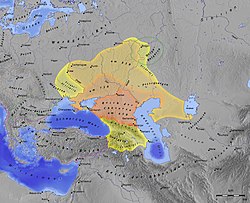
New Study Sheds Light on the Origin of the European Jewish Population

A new and ‘controversial’ paper by Eran Elhaik came out recently in Genome Biology and Evolution.
Despite being one of the most genetically analysed groups, the origin of European Jews has remained obscure. However, a new study published online today (Thursday) in the journal Genome Biology and Evolution by Dr Eran Elhaik, a geneticist at the Johns Hopkins School of Public Health, argues that the European Jewish genome is a mosaic of Caucasus, European, and Semitic ancestries, setting to rest previous contradictory reports of Jewish ancestry. Elhaik’s findings strongly support the Khazarian Hypothesis, as opposed to the Rhineland Hypothesis, of European Jewish origins. This could have a major impact on the ways in which scientists study genetic disorders within the population.
The paper had been around in arxiv.org for months, but we failed to take notice. Here is the abstract.
The question of Jewish ancestry has been the subject of controversy for over two centuries and has yet to be resolved. The “Rhineland Hypothesis” proposes that Eastern European Jews emerged from a small group of German Jews who migrated eastward and expanded rapidly. Alternatively, the “Khazarian Hypothesis” suggests that Eastern European descended from Judean tribes who joined the Khazars, an amalgam of Turkic clans that settled the Caucasus in the early centuries CE and converted to Judaism in the 8th century. The Judaized Empire was continuously reinforced with Mesopotamian and Greco-Roman Jews until the 13th century. Following the collapse of their empire, the Judeo-Khazars fled to Eastern Europe. The rise of European Jewry is therefore explained by the contribution of the Judeo-Khazars. Thus far, however, their contribution has been estimated only empirically; the absence of genome-wide data from Caucasus populations precluded testing the Khazarian Hypothesis. Recent sequencing of modern Caucasus populations prompted us to revisit the Khazarian Hypothesis and compare it with the Rhineland Hypothesis. We applied a wide range of population genetic analyses - including principal component, biogeographical origin, admixture, identity by descent, allele sharing distance, and uniparental analyses - to compare these two hypotheses. Our findings support the Khazarian Hypothesis and portray the European Jewish genome as a mosaic of Caucasus, European, and Semitic ancestries, thereby consolidating previous contradictory reports of Jewish ancestry.
-———————-
For those interested to learn about Khazars, here are few links from relevant time period -
Also check Khazar DNA Project for more information.
-———————
Why controversial? Thanks for asking. The topic of Khazars is a good example of modern day battle between religion, politics and science. ‘Religion’ and ‘politics’ want Khazars to go away, but ‘science’ keeps throwing cold water into their grand plans. If you want to read about these topics, the best book to start with is The Wandering Who by Gilad Atzmon. Also, The Thirteenth Tribe: The Kazar Empire and Its Heritage by Arthur Koestler and The Invention of the Jewish People by Shlomo Sand are supposedly informative, but we have not completed them yet.